Some Windows 10 users have been complaining of an Outlook issue that prevents it from opening properly. This issue is common with all Outlook versions from 2007 to Outlook 365.
The’s a common pattern for this issue – the user installs Outlook, sets it up and the program loads without problems. Then, Outlook is closed but hangs indefinitely at the loading screen while displaying “Loading Profile“. The message remains until forcibly closed. Also, In some cases, it just springs up the “Cannot Start Outlook” Error and doesn’t load at all.

If you’re currently dealing with this issue, we can help. Below you’ll find a collection of methods that have helped Windows 10 users jumpstart Outlook again. But before we get to the fixes, here’s a list of the most common culprits:
- Corrupted Outlook Profile
- Glitched navigation panel
- Bad PST / OST file
- The outlook is starting in compatibility mode
- Outlook does not start with administrator privileges
- Glitched add-in
Now that you know the problem-causers, follow the methods below in order until you find a fix that works.
Note: Before you go through the methods, make sure this isn’t a result of a bad installation. Uninstall your Office suite and run Outlook again. If that didn’t solve your problem, move to the fixes below.
Method 1: Running Outlook as Administrator
This might seem like a cheap fix, but it enabled a lot of users to get their Outlook to work again. So far the fix is confirmed to work on Windows 10, it can’t hurt to try it on an older OS. All you have to do is right-click on the Outlook.exe executable and click on Run as Administrator.

Note: Keep in mind that right-clicking on the Outlook icon might not show you the option to run as administrator. If that’s the case, navigate to C:\ Program Files \ Microsoft Office \ Office 14\15\16 (depending on your Outlook version) and right-click on the executable there.
Method 2: Disabling Outlook’s Compatibility preferences
It’s quite mysterious how Windows 10 decides to launch Outlook in compatibility mode for Windows 7. Some users have reported that their issue was solved once they disabled Outlook running in compatibility mode. Here’s a quick guide on how to check if Outlook is opening in compatibility mode and how to disable it:
- Navigate to where you installed Outlook, right-click on Outlook.exe and select Properties.
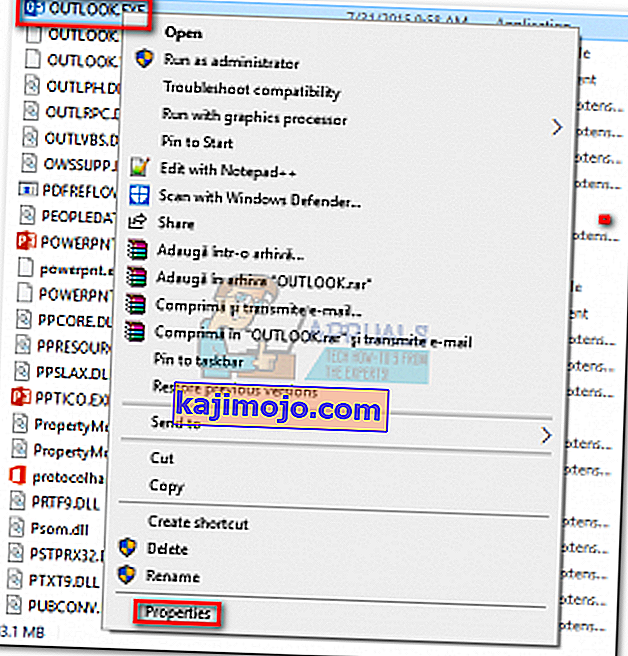 Note: The default install location is: C:\ Program Files \Microsoft Office / Office 14\15\16 (depending on your Outlook version)
Note: The default install location is: C:\ Program Files \Microsoft Office / Office 14\15\16 (depending on your Outlook version) - Select the Compatibility tab and untick the box next to Run this program in compatibility mode for. Click Apply to confirm your selection.

- Open Outlook from the same executable and see if it gets past the “Loading Profile” screen.
Method 3: Resetting the Navigation panel
In Outlook, the navigation panel can be found on the left-side of the screen. It allows easy access to emails, calendars, tasks, and contacts. The trouble is, it can easily glitch out and prevent Outlook from starting properly. Luckily, there’s an easy fix that will reset the navigation panel to its default, non-glitched state. Here’s how to do it:
- Close Outlook completely.
- Press Windows key + R and type “Outlook.exe / resetnavpane” and hit Enter.
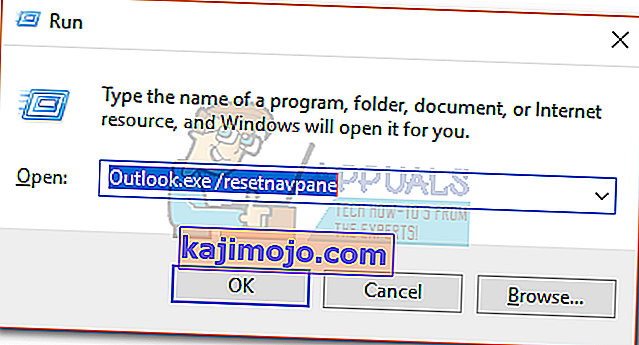
- Outlook will revert to the default state of its navigation panel and open.
Method 4: Opening Outlook in Airplane Mode
This is a temporary fix, but it has worked for a lot of users. As it turns out, cutting off the internet connection during the initial Outlook startup has helped a lot of users get past the Loading profile screen. Now, there are several ways of disabling the network interface, but we opted for using Airplane mode since it’s easier. Here’s what you need to do:
- Close Outlook and all associated dialog boxes.
- Click on the Network icon (bottom-right section of the screen).

- Click the Airplane mode button to activate it.

- Open Outlook and wait until it gets past the Loading Profile screen. Then, click on the network again and disable Airplane mode. After a couple of seconds, Outlook should begin loading your emails, contacts, and calendars.
Method 5: Starting Outlook in Safe Mode and disabling add-ins
Add-ins are great at enhancing Outlook’s already great functionality, but some of them have the potential to glitch out and prevent Outlook from starting again. When you start Outlook in Safe Mode, all add-ins are prevented from loading up. This enables us to deduct if the “Loading Profile” issue is caused by a faulty add-in.
The steps below will walk you through starting Outlook in Safe Mode. If the launch is successful we’ll deactivate every add-in and restart in normal mode. Here’s how:
- Make sure Outlook is completely closed.
- Press Windows key + R and type “Outlook.exe /safe”. Hit Enter to launch Outlook in Safe Mode.
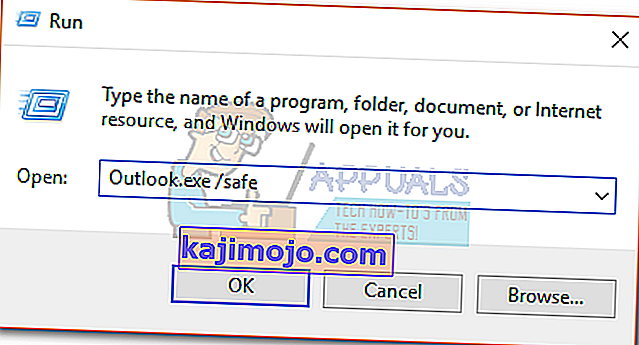
- You might be asked to confirm your Outlook profile. Do so to proceed further.
- Select the File tab and click on Options.
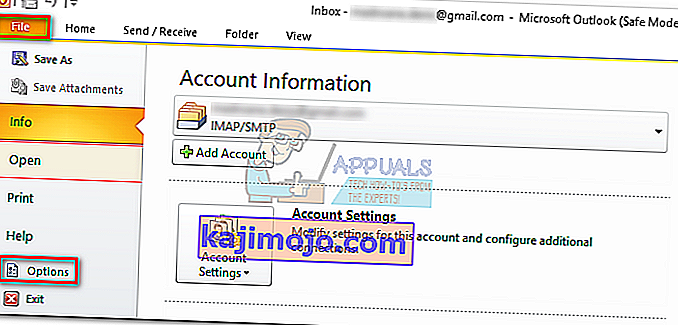
- Click the Add-ins tab, expand the drop-down menu next to Manage and select COM Add-ins. Click on GO.
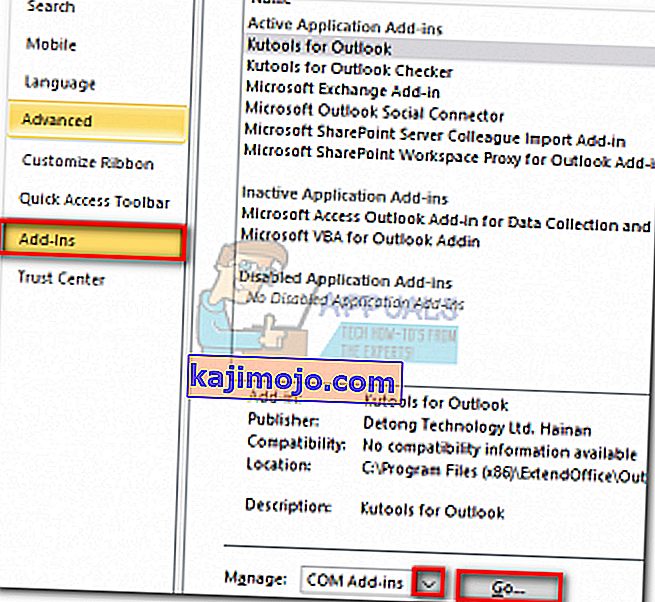
- Un-tick the box next to each add-in to disable it. Hit Ok and close Outlook.
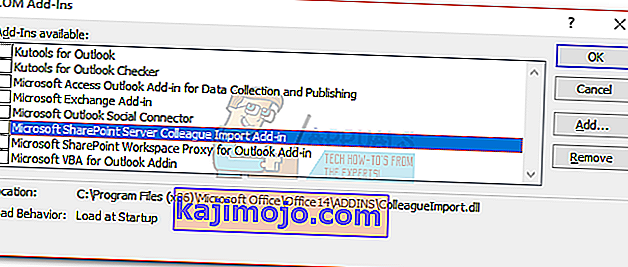
- Restart Outlook normally and see if it gets past the initial screen. If it does, return to File > Options > Add-ins and systematically re-enable the add-ins one by one until you figure out which is causing the issue.
Method 6: Repairing the Outlook data file
Another solution that proved to be effective is to use the Inbox Repair Tool (SCANPST.exe) to perform a general repair on your Personal Folders Profile. Here’s what you need to do:
- Close Outlook completely.
- Navigate to C:\ Program Files and search for SCANPST.exe in the search box located in the top-right corner of File Explorer.
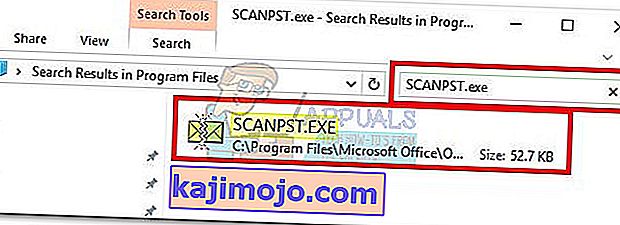
- Double-click on ScanPST.exe and click Browse to set the path of your PST file. The default location is in Documents \ Outlook Files. After the PST is loaded, click Start.

- After the process is complete, you’ll be shown a dialog with the number of inconsistencies found. Tick the box next to “Make backup of scanned file before repairing” and click Repair.
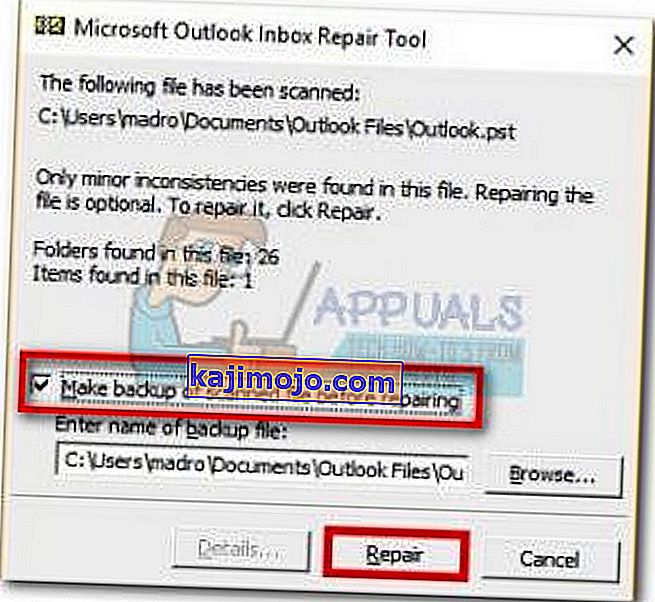
- After the repair is complete, open Outlook again and see if it manages to get past the initial loading screen.
Method 7: Creating a new Outlook profile
Before we can completely eliminate a corrupted profile from the list, let’s create a new email profile and see if Outlook manages to boot up. Here’s what you need to do:
- Close Outlook.
- Apăsați tasta Windows + R , tastați „ control mlcfg32.cpl ” și apăsați Enter.
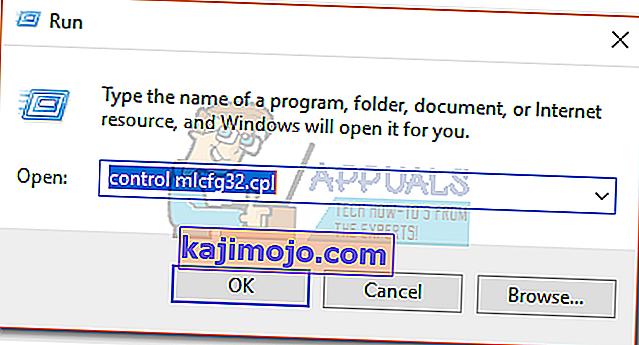
- Faceți clic pe Afișare profiluri .
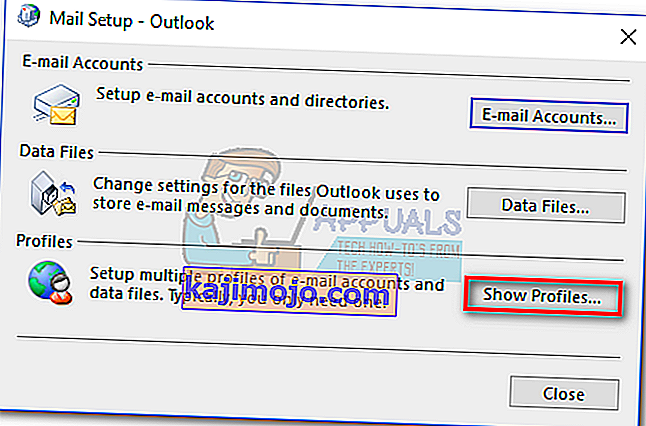
- Faceți clic pe butonul Adăugare pentru a crea un profil nou și introduceți un nume pentru acesta.
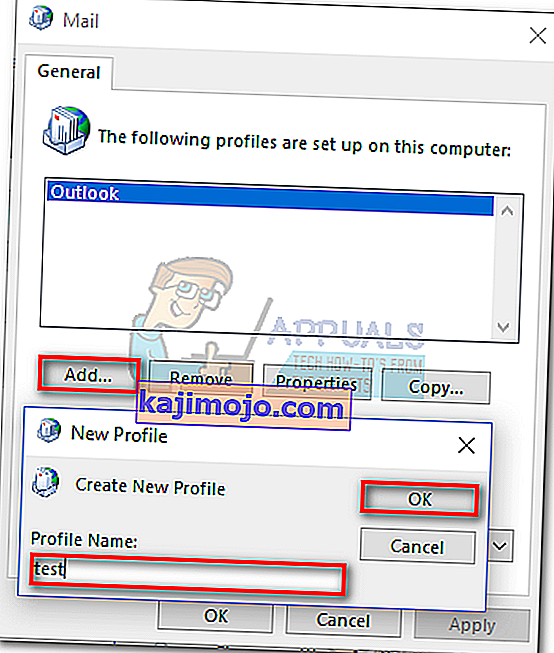
- Utilizați configurarea automată a contului de e-mail pentru a insera acreditările de e-mail și a vă configura contul.
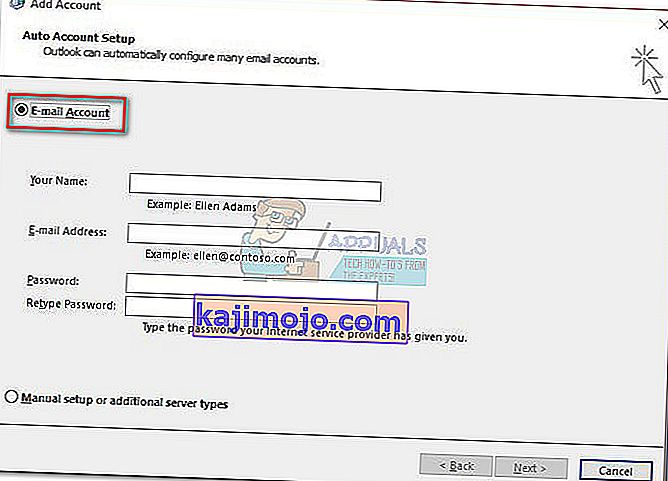
- După ce vă configurați noul profil, reveniți la fereastra inițială de e-mail și faceți din acesta alegerea implicită. Puteți face acest lucru făcând clic pe Utilizați întotdeauna acest profil și selectați noul dvs. profil din listă. Apăsați Aplicare pentru a vă salva preferințele.
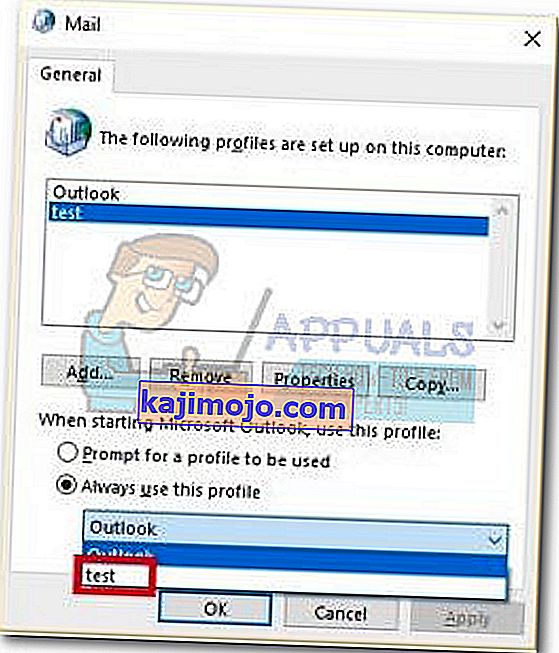
- Porniți Outlook și vedeți dacă problema a fost eliminată.
Metoda 8: Dezinstalarea actualizărilor NET Framework
Mulți utilizatori au raportat că dezinstalarea celor mai recente două actualizări ale .NET Framework a reușit ca Outlook să înceapă normal din nou. Iată cum:
- Apăsați tasta Windows + R și tastați „ appwiz.cpl ” și apăsați Enter .

- Derulați în jos la Microsoft .NET Framework și dezinstalați actualizările 4.5.2.
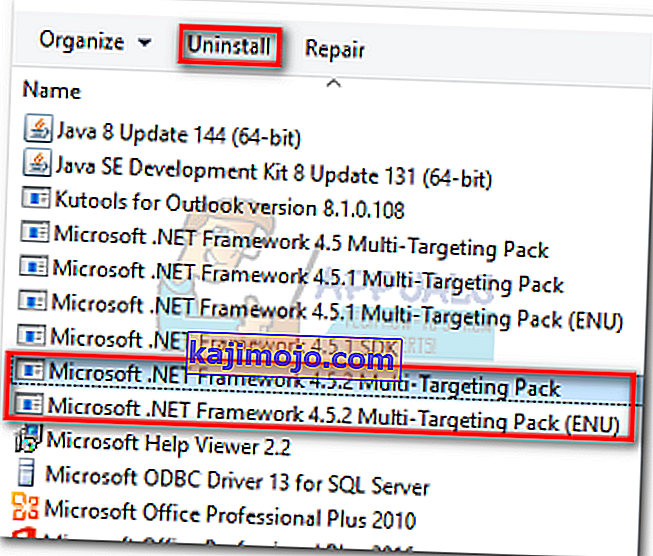
Metoda 9: Închiderea aplicațiilor de fundal
În unele cazuri, anumite aplicații de fundal ar putea utiliza fișiere importante care trebuie lansate de Outlook din cauza cărora s-ar putea declanșa eroarea. Prin urmare, în acest pas, vom închide acele aplicații de fundal. Pentru asta:
- Navigați la următoarea adresă
C: \ Users \ (nume de utilizator) \ AppData \ Local \ Microsoft \ Outlook
- Încercați să redenumiți fișierul aflat în interiorul acestui folder.
- Dacă fișierul este redenumit cu succes, nu continuați cu pașii.
- Dar pentru unii utilizatori, ar putea genera o eroare în timp ce încercați să o redenumiți, această eroare ar putea indica faptul că fișierul este utilizat de o altă aplicație.
- Închideți complet aplicația respectivă și deschideți managerul de activități și verificați dacă nu există nicio instanță care să ruleze în fundal.
- Când aplicația a fost închisă, verificați dacă problema persistă.
Metoda 10: Ștergerea profilurilor Outlook
În anumite cazuri, un profil Outlook s-ar fi putut deteriora în timp și ar putea împiedica Outlook să își încarce resursele în mod corespunzător. Prin urmare, în acest pas, vom șterge profilurile Outlook și apoi vom verifica dacă problema persistă.
- Apăsați butoanele „Windows” + „R” pentru a deschide solicitarea de rulare
- Tastați „Control” și apăsați „Enter” pentru a deschide Panoul de control.
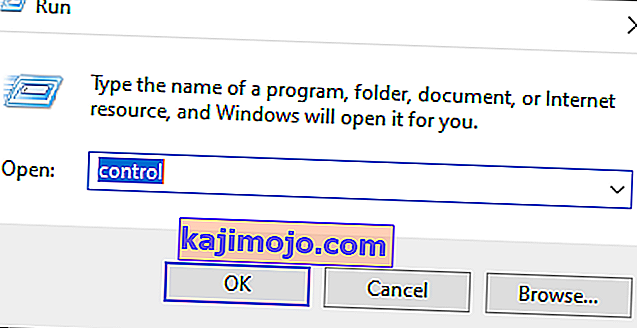
- În Panoul de control, faceți clic pe „Conturi de utilizator” și apoi selectați „E-mail”.

- În fereastra profilurilor, selectați fiecare profil unul câte unul și selectați „Eliminare”.
- După ce faceți acest lucru, faceți clic pe „Aplicați” și apoi pe „OK”.
- Acum, apăsați „Windows” + „ R ” pentru a deschide promptul Run.
- Tastați „Regedit” și apăsați „Enter”.
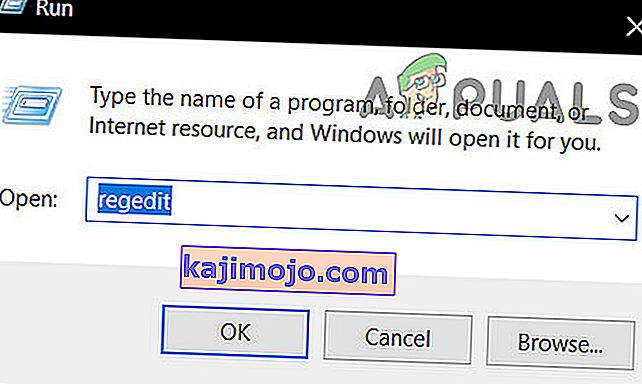
- Navigați la următoarea cheie de registry.
HKEY_CURRENT_USER \ Software \ Microsoft \ Office \ 16.0 \ Profiles
- Eliminați și toate profilurile de aici.
- Acum, porniți Outlook și vă va cere să vă conectați cu acreditările dvs. și apoi să creați un profil nou.
- Verificați dacă problema persistă.
Metoda 11: Eliminarea cheii Office
În unele cazuri, din cauza unei actualizări de la o versiune mai veche a Microsoft Office la una mai nouă, este posibil să aveți câteva chei rămase din instalarea anterioară. Prin urmare, în acest pas, vom șterge acea cheie și apoi vom verifica dacă problema persistă.
- Închideți toate instanțele Microsoft Outlook și Office.
- Apăsați „Windows” + „R” pentru a deschide promptul de rulare.
- Tastați „Regedit” și apăsați „Enter”.

- În registru, navigați la următoarea locație.
HKEY_CURRENT_USER \ Software \ Microsoft \ Office
- Aici, ștergeți cheia dintr-o versiune anterioară de Office și creați un nou profil Outlook așa cum este indicat în metodele anterioare.
- Verificați dacă problema persistă.
Metoda 12: lansarea IP
În anumite cazuri, problema ar putea fi rezolvată prin eliberarea IP-ului în timp ce ecranul profilului de încărcare este blocat și apoi reînnoirea acestuia după pornire. Acesta este un fel de soluție și ajută la reducerea erorilor datorate configurației IP incorecte. Pentru a implementa această soluție:
- Lansați Outlook și așteptați ca acesta să se blocheze pe ecranul „Încărcare profiluri”.
- Apăsați „Windows ' + „ R' pentru a deschide promptul de rulare.
- Tastați „cmd” și apăsați „Shift” + „Ctrl” + „Enter” pentru a furniza privilegii administrative.

- Tastați următoarea comandă și apăsați „Enter” în timp ce ecranul este blocat pe Outlook.
Ipconfig / release
- Acum, ecranul Outlook se va încărca și ar trebui să vă treacă. În acest caz, tastați următoarea comandă și apăsați „Enter”.
Ipconfig / reînnoire
- Faceți clic pe „ Trimiteți / primiți toate folderele ” în Outlook și verificați dacă problema persistă.
Metoda 13: Dezactivarea accelerării hardware
În anumite cazuri, accelerarea hardware pentru Outlook ar putea fi activată din cauza căreia unele componente ale aplicației ar putea să nu se încarce corect. Prin urmare, în acest pas, vom dezactiva accelerarea hardware după rularea aplicației ca administrator.
- Faceți clic dreapta pe pictograma Outlook.exe de pe desktop și selectați „Rulați ca administrator”.
- Așteptați ca aplicația să fie lansată corect.
- În Outlook, faceți clic pe opțiunea „Fișier” și apoi selectați „Opțiuni”.
- Faceți clic pe „Avansat” și apoi faceți clic pe „Afișare”.
- Bifați opțiunea „ Dezactivați accelerarea hardware ” în Outlook.
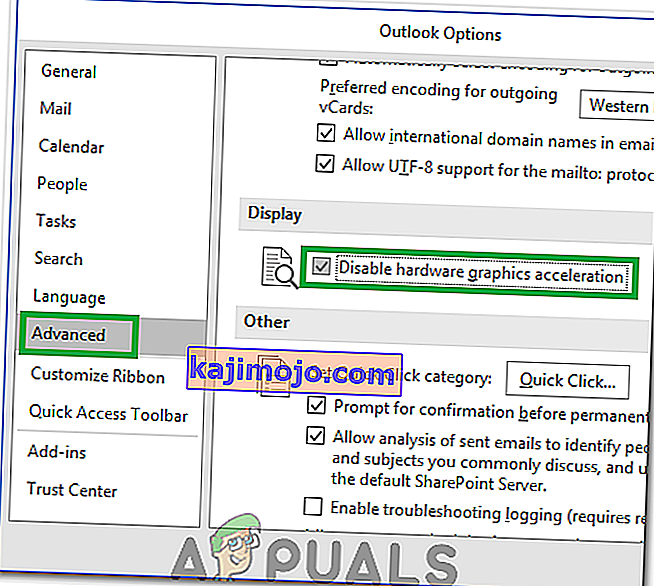
- Verificați dacă problema persistă.
Alternativ:
- Apăsați „Windows” + „R” pentru a deschide solicitarea Run.
- Tastați „Regedit” și apăsați „Enter”.

- Navigați la următoarea locație din editorul de registry.
HKEY_CURRENT_USER \ Software \ Microsoft \ Office \ 16.0 \ Common
- Creați o nouă cheie aici și denumiți-o „Grafică”.
- Selectați tasta Grafică, faceți clic dreapta și selectați nou, apoi faceți clic pe opțiunea „ DWORD (32-bit) Value” .
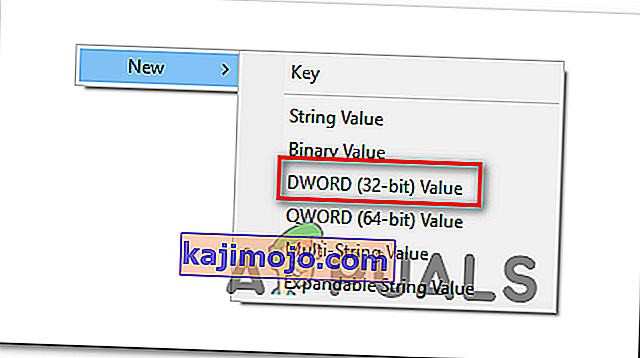
- Denumiți acest „ DisableHardwareAcceleration” și schimbați valoarea acestuia în „1”.
- Închideți editorul de registru și verificați dacă problema persistă.
Remedii generale:
- Asigurați-vă că eliminați toate e-mailurile și parolele salvate din Managerul de acreditări Windows.
- Asigurați-vă că verificați nivelul de securitate al Gmail și verificați dacă acesta este setat pentru a permite Outlook să se poată sincroniza.
- Verificați dacă instalarea Office nu coincide cu Outlook.

 Note: The default install location is: C:\ Program Files \Microsoft Office / Office 14\15\16 (depending on your Outlook version)
Note: The default install location is: C:\ Program Files \Microsoft Office / Office 14\15\16 (depending on your Outlook version)






















